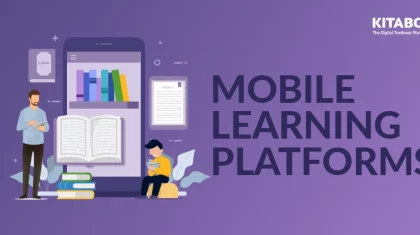
The K12 Publisher’s Guide to Privacy Compliance Without the Headaches
Summarize this blog with your favorite AI:
One data breach. One compliance misstep. That’s all it takes to derail a K12 edTech product—and your reputation.
For education publishers, privacy compliance is a legal necessity and a lifeline. As FERPA, COPPA, and CCPA regulations tighten, the stakes for safeguarding student data privacy have never been higher. However, navigating the rules often delays product launches, frustrates districts, and exposes publishers to costly penalties.
The solution? Proactive, embedded compliance—not reactive chaos. Modern tools like KITABOO, a digital textbook platform leading the way, are rewriting rules by incorporating privacy safeguards directly into product design. It is that silent compliance that works in the background leaving no guesswork and accelerating the time-to-market.
This guide cuts through the complexity, offering actionable strategies to align with K12 privacy compliance standards effortlessly. Discover how to turn regulatory hurdles into competitive advantages—and ensure your next product rollout isn’t just compliant but confidently secure.
Table of Contents:
I. Understanding the Regulatory Landscape
- FERPA: Protecting Student Education Records
- COPPA: Safeguarding Children’s Online Privacy
- CCPA: Addressing Data Rights for California Residents
II. Simplifying Compliance with Built-In Solutions
- Automated Data Encryption and Access Controls
- Streamlined Consent Management Systems
- Regular Compliance Audits and Reporting
III. Building Robust Student Data Protections
IV. Best Practices for Seamless Policy Updates
- Monitor Regulatory Changes Proactively
- Collaborate with School Districts
- Educate Internal and External Stakeholders
V. Checklist for K12 Privacy Compliance Success
VI. Conclusion
Understanding the Regulatory Landscape
K12 privacy regulations, including FERPA, COPPA, and CCPA, need to be navigated well. Failure to comply could result in penalties and delayed product launches. Here’s an overview of the regulations:
FERPA: Protecting Student Education Records
Access to student data is governed by the Family Educational Rights and Privacy Act (FERPA). Publishers need to obtain written consent prior to sharing directory information. Digital platforms make FERPA compliance easier with fine-grained permission settings.
COPPA: Protecting Children's Online Privacy
Children’s Online Privacy Protection Rule (COPPA) requires verifiable parental consent for collecting information from children under 13. Platforms that integrate age-gating and consent workflows reduce administrative burdens.
CCPA: Addressing Data Rights for California Residents
Simplifying Compliance with Built-In Solutions
Navigating K12 privacy compliance requires precision, but manual processes often create bottlenecks. Built-in solutions automate critical tasks like consent management and data encryption, minimizing human error.
Manual compliance processes are error-prone. By embedding safeguards into product design, publishers reduce delays while aligning with evolving education compliance standards. Integrated tools streamline adherence to privacy regulations:
Automated Data Encryption and Response Plans
Data breaches threaten K12 privacy compliance, but robust encryption neutralizes risks. AES-256 encryption protects data at rest (stored) and data in transit (transmitted) and meets rigorous education standards.
Publishers must create and implement data retention policies to describe the duration student data will be retained and destroyed. They must have a data breach response plan to manage any possible data breaches.
Streamlined Consent Management Systems
Parental consent remains a cornerstone of COPPA and FERPA adherence, yet manual tracking often causes delays. Centralized dashboards automate consent collection, storage, and renewal, offering real-time visibility into permissions.
Features like automated reminders for expiring consents and self-service portals support parents in updating preferences effortlessly.
Regular Compliance Audits and Reporting
Proactive audits are non-negotiable for sustaining privacy regulations compliance. Automated audit logs capture granular details—user logins, data modifications, and file access—creating an immutable trail for accountability.
Prebuilt report templates tailored to FERPA, COPPA, or CCPA requirements simplify submissions to districts and regulators.
Building Robust Student Data Protections
Student data privacy hinges on proactive defense mechanisms against breaches and misuse. Robust protections include role-based access controls, end-to-end encryption, and anonymization of sensitive information.
We must prioritize data protection in schools with granular permissions and audit trails, ensuring only authorized users interact with records. Such layered strategies not only meet privacy regulations but also increase trust among educators and families.
Proactive measures prevent unauthorized access and misuse:
Implementing Role-Based Access Controls
The K12 publishers need to take proactive measures to secure the information they gather. One of the best methods by which this can be achieved is by implementing role-based access controls.
Role-based access controls restrict the access to data to authorized personnel only. This implies various users have varying levels of access to student data based on their role in the organization.
For instance, teachers can be provided access to student grades and attendance records, whereas administrators can be provided access to more sensitive data, such as student disciplinary records.
Adopting Data Minimization Strategies
Another important step in protecting student data privacy is to adopt data minimization strategies. This means collecting only the essential student data needed to provide educational services.
Platforms with customizable fields can help publishers avoid unnecessary information retention. By limiting the amount of data collected, publishers can reduce the risk of data breaches and misuse.
Best Practices for Seamless Policy Updates
Privacy regulations evolve constantly, demanding agility from K12 publishers. Proactive monitoring of legislative changes and stakeholder collaboration are vital. Platforms offering real-time compliance alerts simplify policy adjustments while maintaining district requirements.
Training teams on updates and refining internal protocols ensure seamless transitions, avoiding disruptions to product rollouts or district partnerships. Regulations evolve; preparedness prevents disruptions:
Monitor Regulatory Changes Proactively
Identify reputable sources that provide updates on education privacy legislation. This can include legal newsletters, industry associations, or government websites. Explore software and platforms that offer compliance alerts and tracking features.
These tools can help you stay informed about changes and assess their potential impact on your products and services.
Collaborate with School Districts
Establish open communication channels with district IT departments. They are often the first point of contact for implementing and enforcing privacy policies within their schools. Don’t assume a one-size-fits-all approach to privacy.
Districts may have specific interpretations or implementations of broader regulations. Working towards shared compliance frameworks strengthens trust and streamlines the process for both publishers and districts.
Educate Internal and External Stakeholders
Provide regular training to your teams on relevant privacy regulations and your company’s specific policies. This includes everyone involved in the handling of student data, from product development to customer support.
Ensure that your user guides and documentation clearly explain your data privacy practices to schools, teachers, and students. Use plain language and avoid legal jargon.
Checklist for K12 Privacy Compliance Success
A structured checklist transforms complex regulations into actionable steps. Start by auditing data collection practices, encrypting student information, and verifying consent mechanisms.
Various solutions offer prebuilt templates for audits and reporting, accelerating compliance workflows. Regular reviews and stakeholder alignment ensure sustained adherence to education compliance standards, mitigating risks and enhancing market readiness.
- Conduct a data inventory to identify sensitive information.
- Encrypt all student data and implement access controls.
- Integrate parental consent mechanisms for COPPA adherence.
- Establish procedures for CCPA data deletion requests.
- Schedule quarterly compliance audits and staff training.
Conclusion
K12 privacy compliance doesn’t have to slow you down. While FERPA, COPPA, and CCPA regulations can be tricky for publishers, staying on top of them with smart strategies can keep you moving forward.
This guide shows that with automated workflows, strong data protection, and real-time policy updates, compliance can fuel innovation instead of holding it back.
Platforms like KITABOO have built-in tools—automated encryption, granular consent management, and audit-ready reporting to refine the compliance processes. In doing so, it transforms compliance from a roadblock into a competitive edge, accelerating market entry and solidifying district partnerships.
To know more, get in touch with us now!
Also Check:
Discover how a mobile-first training platform can help your organization.
KITABOO is a cloud-based platform to create, deliver & track mobile-first interactive training content.



